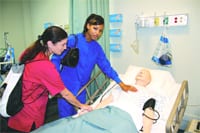Less Ouch, More Ahhh Advances in Technology Help Make Living with Diabetes Easier
“Today’s devices are all equally accurate,” said Wally Footit of Louis and Clark Medical, a medical supply store in Springfield. “And they operate in basically the same way. There’s a lancet to puncture the skin. There’s the test strip where you put the drop of blood. And there’s the monitor, where you insert the strip with the blood for testing. The only things that vary are the amount of blood required for the test and the time it takes to get a reading. And the times don’t vary by much.”
Today, all of the home glucose testing monitors require users to prick themselves to draw a blood sample. The smaller the sample, the less deep the puncture needs to be. And the shallower the puncture, the less pain is felt by the user. One monitor on the market, ‘The Flash’ manufactured by FreeStyle, only requires a drop of blood about the size of the head of a pin.
Some blood glucose monitoring systems, like the kind currently endorsed in television commercials by blues guitarist B.B. King, allow for alternate site testing. They let users draw blood from areas on their body other than their fingertips. Langlois sees this as one of the most significant technological advances.
“In the past, they were using strictly fingertips,” she said. “That made them sore and it deterred people from testing. And you can imagine if you had a child, having to inflict that kind of pain four or five times a day.”
With alternate site testing, blood can be drawn from the palm, forearm or abdomen. The alternate sites, combined with shallower punctures, have greatly reduced the pain and discomfort of regular testing.
Other significant advances in home blood glucose monitoring systems include:
• Power triggered by the insertion of a testing strip. Users no longer need to worry about powering the unit on or off. The early versions also required time to warm up.
• Memory. Some units can record up to 500 tests.
• Time and date. Most units record the time and date of each test.
• Computer compatibility. Some units enable users to download the test information to their computers. The data can be converted into a graph so the user and doctor can track results and identify trends.
• Testing strip cartridges. Since the strips are thin and narrow, they require some dexterity for users to insert them into the monitor. Since neuropathy can be a complication from diabetes, dexterity can be a problem. The cartridges remove the need for dexterity since they’re pre-loaded and eject a strip just far enough for the user to apply a drop of blood.
While these advances in monitors have made the process less intrusive and painful, there is still more to be done.
“We’ve come a long way, but the monitor companies have nothing to force them to go the next step, which would be to have the meter analyze and tell the patient what to do with the data they get,” said Janet Foss, R.N. and diabetes program coordinator at Baystate Medical Center. “They get numbers, but we have to train the patients on what to do with those numbers.”
As monitoring systems have improved, so has the insulin- delivery system. Needle size has become smaller and users have access to insulin pens. The pen is a system where the user dials a dose and it’s ready to go with a pre-mixed, pre-filled solution.
Another significant advance is the insulin pump. Users wear the pump at all times. It delivers a basal level of insulin. The benefits are that it gives greater freedom, especially regarding what and when an individual eats, since the pump delivers a steady flow of insulin. Users simply adjust the flow according to the glucose test. However, the pump can be cumbersome. And there’s the concern about possible infection at the insertion point or a malfunction.
Forecasting the Future
“The philosophy about diabetes is changing. The technology is changing. The patients are changing,” said Langlois. “They’re becoming a lot more proactive and are demanding more information than they did years ago.”
The good news is that the technology is there to get them what they need.
Testing is under way on nasal spray as a possible way to deliver insulin, which could do away with the pump and injections.
On the monitoring front, manufacturers are looking at infrared technology as the next big thing. Infrared monitoring will do away with the need to puncture the skin to draw a blood sample. Infrared technology already is used in hospitals to measure oxygen levels in blood. The hope is that the same can be done to measure glucose levels, too.
While these advances would make living with diabetes easier and better, Foss knows there’s only one breakthrough that will truly improve the lives of all diabetics.
“A cure would be the best thing.”



